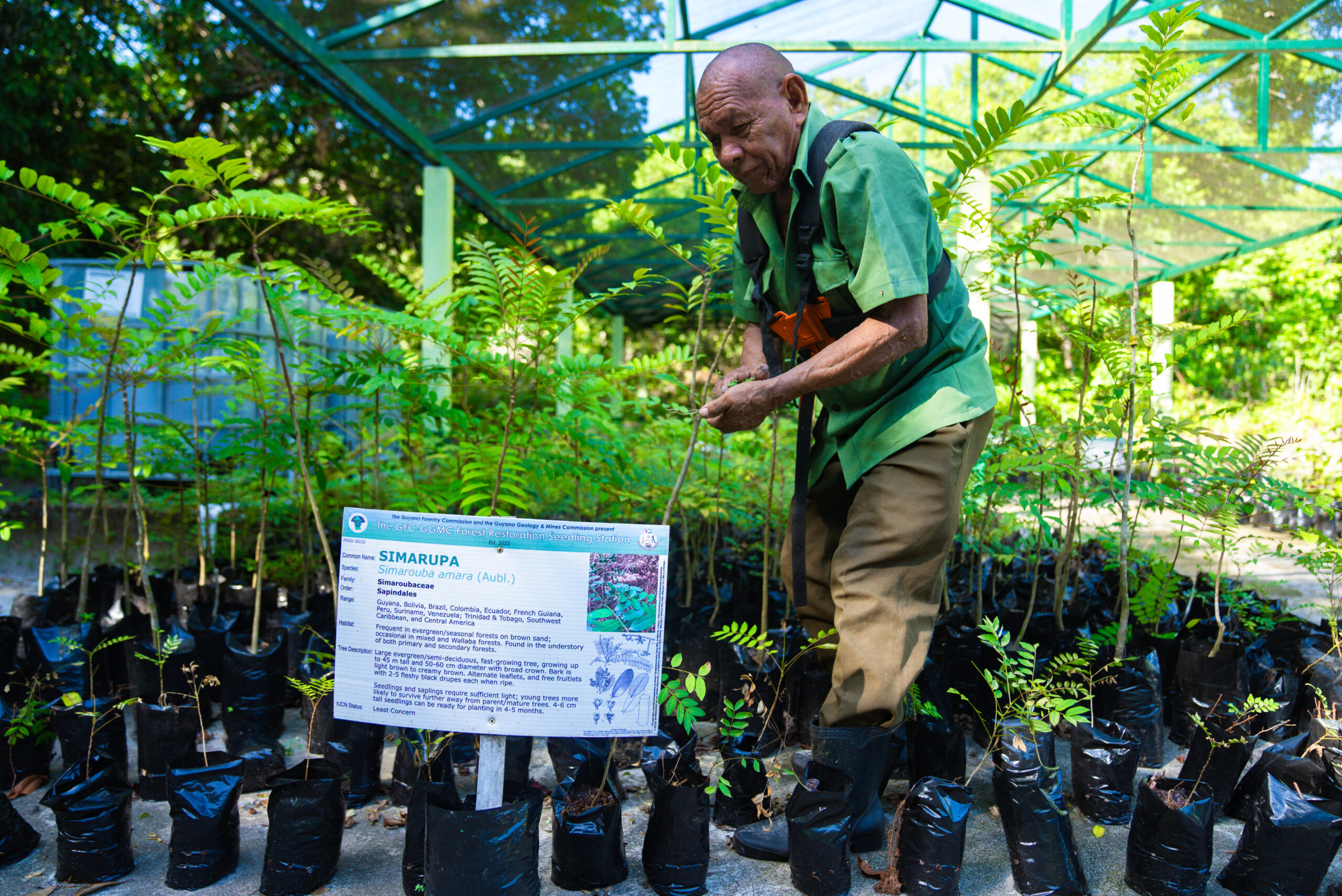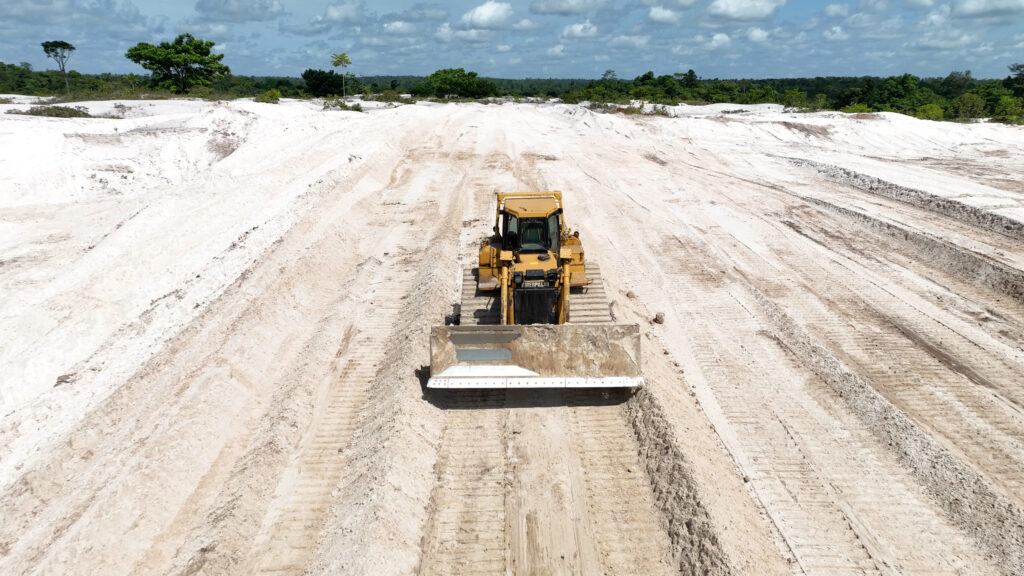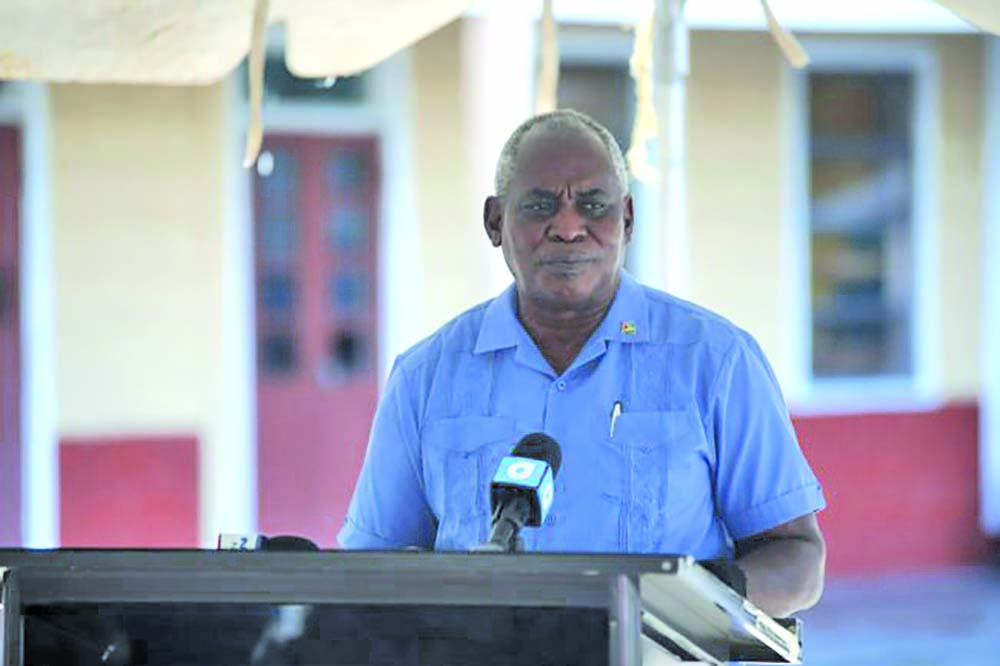
By Neil Marks
At Dakoura, 65 miles south of Guyana’s capital Georgetown, bulldozers and excavators work to fill in a crater left from bauxite mining.
Once this work is done, it will be time to treat the land and plant trees, most of them prized for high-value timber.
The idea is to restore the area to what it once was before mining – green, and not the white sandy dent in the surrounding forest.
It’s just 23 hectares, a rather tiny patch when you consider that Guyana already has 18 million hectares of land covered by forest.
In fact, Guyana, part of South America’s giant Amazon, has the second highest forest cover in the world, with 85 per cent of its total land area covered by forests of various kinds, mainly rainforest and montane forests.
But even a small disturbance in that forest cover, as in the case at Dakoura, is cause for concern.
“We know how the ecosystem functions. It’s one system, you know. If you have a system broken, or you leave it fractured, naturally it has implications for us as Guyanese,” says Godfrey Scott, who heads the Reclamation Unit within the Guyana Geology and Mines Commission (GGMC), the legal body that oversees all mining operations in Guyana.
Mining is the main driver of deforestation in Guyana. Last year, an estimated 6, 470 hectares of the country’s forest was cleared, most of it because of mining.
“Mining disrupts the environment, and if we don’t adopt a system that at least attempts to make it whole, or intact, that has implications for us as Guyanese,” says Scott, pointing out the valuable ecological services the forests provide, such as hunting grounds and fresh water for indigenous communities.
Scott and his colleagues are working with those at the Guyana Forestry Commission (GFC) to reforest some 200,000 hectares of forest cleared over recent years for mining and other activities, such as agriculture and the building of roads.

Guyana has continued to maintain one of the lowest deforestation rates in the world (0.02-0.079%), coming in at one 1/10th of the global deforestation rate.
Chandroutie Sookdeo, who works in the Forest Areas Assessment Unit of the GFC, maps deforestation and forest degradation using satellite imagery.
On a visit by the News Room to the GFC last week, she pointed to an area straddling the gold-rich Regions One and Seven which was destroyed by mining last year. Her work allows her to determine the exact area size – 8.4 hectares.
She estimated that the total forest area removed in Guyana last year was 6, 470, hectares leading to a deforestation rate of 0.034 per cent and the release of about 10.6 million tonnes of carbon dioxide; the deforestation rate was lower than in 2021 when it was 0.042 per cent.
|Graphic shows the main reasons for deforestation in Guyana for the year 2022 and the amount of carbon dioxide emitted as a result. (Source: Guyana REDD+ Monitoring Reporting & Verification System Report for 2022)
It is this deforestation that the Mines and Forestry Commissions is seeking to restore. And it’s no idle exercise to plant back trees just for the sake of hiding blemishes to the country’s forest cover.
For example, at Dakoura, an experiment in reclaiming land by the GGMC previously led to the planting of Acacia trees, which are ideal for greening an area quickly, as they spread rapidly, says Shuba Soamandaugh, a Forestry Management Expert and an Assistant Commissioner of Forests.
But this time around, the acacia trees are not being used; the area in Dakoura will be planted using native and pioneer species such as Simarupa, Tauroniro, Kaditiri, Bloodwood and Awati.
The seedlings are being grown in a nursery set up by the GFC and once hardened, they will be planted at Dakoura. The seedlings are harvested from the forest surrounding Dakoura.
Somandaugh says these species are ideal for harsh conditions, such as those posed by Guyana’s hilly sand and clay belt where Dakoura is.
|Video shows the damage caused by mining, the main driver of deforestation, along a river in Region Eight. (Video: News Room)
“Pioneer species have a few characteristics – they can occur in harsh environments, they can survive on little nutrition, and they are very good at remediation, reclaiming land,” Somandaugh asserts.
But importantly, she says these species are of high timber value and it is the intention that the reforested area could later be allocated for community forestry operations.
The Forestry Commission’s sustainable management guidelines do not allow clear-cutting but selective logging, so any allocations to the restored areas will prevent the clearing of the land.
Rawle Lewis, Deputy Commissioner for the Forestry Resource Management Division of the Forestry Commission says apart from Dakoura, restoration activities are slated for deforested areas in Matthews Ridge at the top of Guyana and at Bartica, almost at the centre of the country.
“It is a very expensive procedure; it’s not a cheap exercise,” Lewis asserts, but he says the value to Guyana and the world in restoring the forest is critical.
“These were initially naturally forested areas,” he notes, pointing out the important roles forests play in sequestering or trapping harmful greenhouse gases, such as carbon dioxide, from the atmosphere. The presence of these gases is what scientists attribute to changes in the climate, leading to severe weather events such as wildfires and catastrophic floods.
Guyana’s forest is meticulously managed to ensure as limited deforestation as possible.
At the Forestry Commission, Lashanna Lilly manages a centralized database and helps determine for the Commission which areas can be allocated as a forestry concession. And, once the allocations are made, the department also ensures that the owners comply with the coordinates of their concessions.
Currently, there are 548 small concessions (everything below 20,000 acres) and 18 large concessions.
Lilly says all concessions, large and small, are concentrated above the fourth parallel (the most narrow part of Guyana) or an area around the village of Apoteri in Region Nine going upwards. What falls below that is virgin rainforest.

The country’s combined rainforest, documents presented by the Government of Guyana to the United Nations climate change body, is said to store 19.5 gigatons of carbon. The country has studiously avoided cutting down the forests to prevent the carbon from being released into the atmosphere and exacerbate climate change.
However, the country argues it must find alternative sources of revenue to develop and has set about trading the carbon.
Its first forest-saving deal was with Norway for US$250 million and last December, American Oil Company, Hess Corporation bought into a carbon credits deal that will see it buying 37.5 million REDD+ jurisdictional carbon credits, giving the government US$750 million – 15 per cent of which it has pledged to indigenous communities. REDD+ is the United Nations’ mechanism to prevent the destruction of the world’s rainforests because of the important role it plays in mitigating climate change.
The initiative to once more grow trees in deforested areas and the carbon credits scheme fits into Guyana’s Low Carbon Development Strategy (LCDS), which is essentially Guyana’s plan to keep the forest standing while pursuing ventures that would bring wealth to citizens.
“We understand the importance of our forests for life in the global community. We understand the significance of the forests for biodiversity studies and for the advancement of modern medicine and research and development and importantly, we know for a fact the value of that forest knocked down and for the value of the forest standing,” President Irfaan Ali said at the University of Guyana this week during a conversation with former UK Prime Minister Tony Blair.
“I think you’re in a very strong leadership position on this because you’re one of the very, very few countries in the world that actually prefer to preserve their rainforests,” Blair said.
Within the next two to three years, the mined-out area in Dakoura should be green again.












